[ Page 6 ]
1/72 scale kits of the Mikoyan Gurevich MiG-21
... continued from MiG-21 page 5....
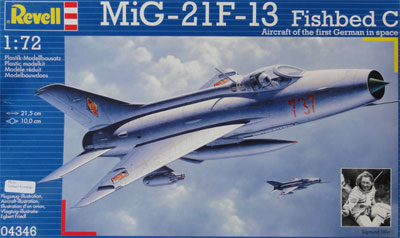
Another kit of the fine Revell MiG-21 F13 kit #04346 (as described on page 2) was tackled but now to be converted into a Chengdu F-7 export modern version F-7 M "Air Guard".
The Chinese J-7 was the Chinese license-built Soviet Mikoyan Gurevich MiG-21 F13. It had the standard delta wing but was fitted with the Wopen WP-7 engine which was a licensed copy of the Soviet Tumansky R-11F-300. The Chengdu Jian J-7 Type 62 was built by Factory 132 near the city of Chengdu in Sichuan Province. The role of this jet was as a high-speed "day fighter". The first flight of the J-7 was in January 1966. The J-7 "I" could fire PL-2 (R-3S copy) air-to-air missiles, retained the forward-hinged canopy. The long pitot tube was moved to on top of the intake. The J-7 flown by the Chinese PLAAF Air Force had 1 cannon. (see previous model made on this page....). The J-7 was further developed. The J-7 "II" was equipped with a different ejection seat, different cockpit canopy and improved WP-7B engine. It got a parachute in a tail fairing to reduce landing runway length.
The J-7 "III" (J-7C) and "IV" (J-7D) were based on the MiG-21 MF but ran into production problems and not a lot of these were put into service.
A Chinese two-seat trainer JJ-7 was also developed which was built in Guizho and of which most had a single different 23 mm practice cannon. The JJ-7 was based on the MiG-21U "Mongol-A" but fitted with 2 ventral fins (and not 1 as on the Soviet original) and Type 2 ejection seat; JJ-7 first flight was in 1985. The following JJ-7 "II" got fitted with Collins avionics.
In 1987 it was decided to sell the J-7 "II" single seat fighter for export as F-7. The cockpit canopy was made somewhat more “bulged/ convex” and the rear windows were removed and closed. These F-7 export jets were also equipped with 2 cannons of 30 mm with thus an extra cannon on the port side/left side at both lower fuselage sides in front of the straight delta wing. A pair of extra pylons could be installed, so now totalled four.
For the following version J-7E a major design change was a new double-delta cranked wing and better avionics. This J-7E was powered by a WP-13F jet engine and equipped with a sort of copy of the GEC Marconi radar and a HOTAS system. It had a single 30 mm canon and 4 pylons that could fire PL-4 and PL-8 missiles. First J-7E flight was in May 1990. The J-7G followed with new radar from Italian origin and helmet mounted sight and different windshield. (The J-GB is the unarmed version for the aerobatic display team "August 1"). Some air forces that bought the type often installed for example better ejection seats like from Martin Baker if they could affort it like Pakistan. But other air forces retained the supplied Chinese ejection seat.
A much improved F-7 version was F-7M "Air Guard" that featured Western avionics. There were several main external changes to the initial J-7 "II". It featured 2x 30mm canons, brake parachute installed in a fairing below the rudder, a different large canopy and four wing pylons. The thicker main tyres are about 60cm in diameter. The long pitot was "back" relocated to below the intake. The F-7M can fire Western weaponry like Rafael Python 3 and probably "Magic" air-to-air missiles, all enabled by the Western avionics.

This Revell model will be converted for a F-7M Air Guard of Myanmar ("Burma") air force with a camouflage scheme. Myanmar obtained probably some 10 aircraft with delivery starting in 1991. These were followed by about 48 F-7BK, very similar to the previous F-7 "II" K, but which had a rear fuselage change to cope with the uprated hotter engine heat. This is difficult to see in 1/72.
The Myanmar markings are from a AZTEC set 72052.
As one canon fairing is fitted standard on the MiG-21 F13, I crafted on the kit the needed second canon fairing at the other left/ port side for the F-7M.
The Chinese parachute fairing below the rudder was made from a spare "bomb" blended in with putty.
Some putty was used. After sanding the basic model got a light grey base paint to check for any corrections that may be needed.
The camouflage colours are difficult to determine: Aztec suggests FS36280/34226 for the grey and FS34094/34079 for the green.
I settled for these airbrushed acrylics after studying numerous photos:
- lower surfaces AKAN 73008 light blue;
and after masking....
- grey Gunze Sangyo 331 approx RAF Dark Sea Grey BS 638;
- green Gunze Sangyo 302 approx FS34092.

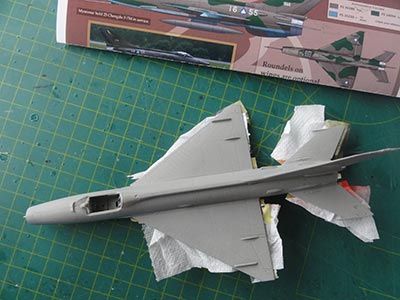
Between the camouflage colours the demarcations are soft, this was done by free hand airbrushing and a bit of masking.
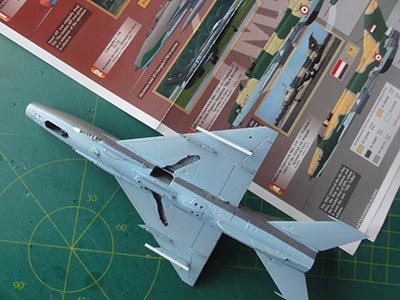
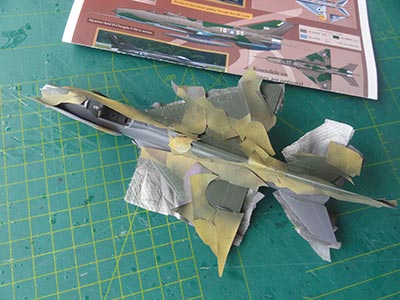
The canopy was now tackled. It has a different configuration as the old standard MiG-21 F13/ Shenyang/ Chengdu J-7 and the "Air Guard" has now a windscreen and upward tilting rear canopy. I simply cut the kit parts with a razor saw. It is may be not 100% correct for a "bulged" canopy but good enough at this scale.
The F-7M Air Guard windscreen and canopy parts were set in place. Fill any small gaps with white glue and paint the frames in the surrounding camouflage colours and the rear small window was "over painted".
The cockpit interior was painted medium grey. The ejection seat was probably not changed as some sources suggest the Myanmar air force did not have the funds or need for better Western ejection seat.(in Pakistani F-7M Martin Baker mk.10 seats are used). I simply kept the Revell seat as per kit as a Chinese type.
The decals were set onto model as per Aztec instructions after a gloss surface was achieved by airbrushing gloss Gunze Sangyo H30 clear varnish (often alternatively I also airbrush Johnson Future / Pledge).
The remainder of the parts were installed like the landing gear. I used the standard kit parts and wheels although it is reported that the F-7M wheels are a bit thicker and larger in diameter but in 1/72 hardly noticable.
Four pylons were set below the wing (with 2 extra pylons of the F-7 export coming from other kit spares). I got a modern Israeli Python-3 missile from a AMK Kfir model that was installed on launch rail made from plastic strip.
A few small antennas were added as well as the standard 490 liters central fuel tank.
Finally a bit weathering was done with thinned darker paint applied in the recesses of flaps, brakes with a fine brush. The model got a matt varnish coat airbrushing Johnson Future / Pledge with some 15% mixed in Tamiya X-21 Flat Base, giving it a matt sheen and to protect the decals.
Update: add 5% Gunze Sangyo Levelling Thinner for an even better airbrush spray.
MYANMAR ("Burma")



[ 676,500 sq.km | population: 54 million | capital: Naypyidaw | GDP per capita USD 1,400 ]
Burma or Myanmar as the country is known from 1989 is in South East Asia. It became independent in 1948 but the Burmese air force was set up earlier in 1947 though it was still under British rule. Read more about the air force on the K-8 page here....
The F-7M "Air Guard" was a modernized J-7 II ("F-7B of F-7iiK"). Myanmar obtained probably some 10 aircraft with delivery starting in 1991. These were followed by about 48 F-7BK , very similar to the previous F-7iiK, but which had a rear fuselage change to cope with the uprated engine heat.
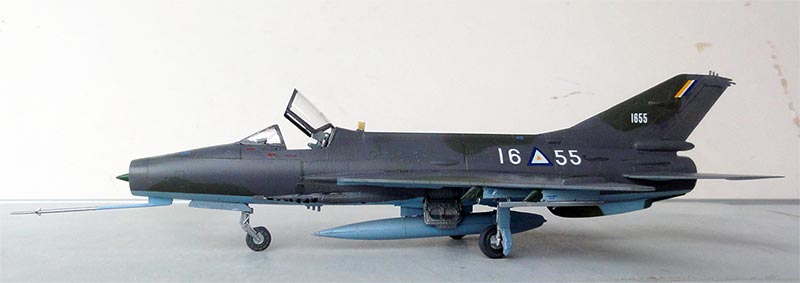
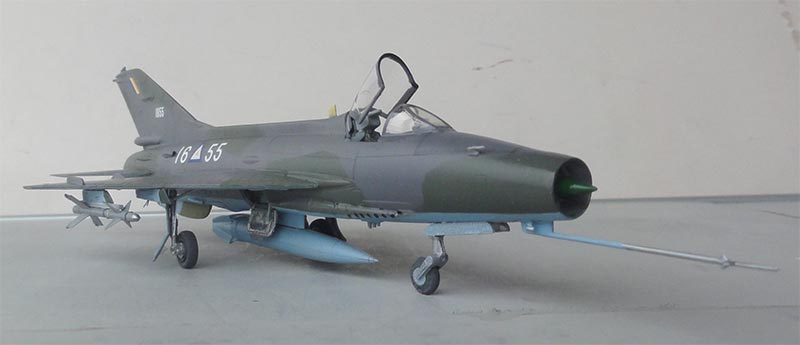
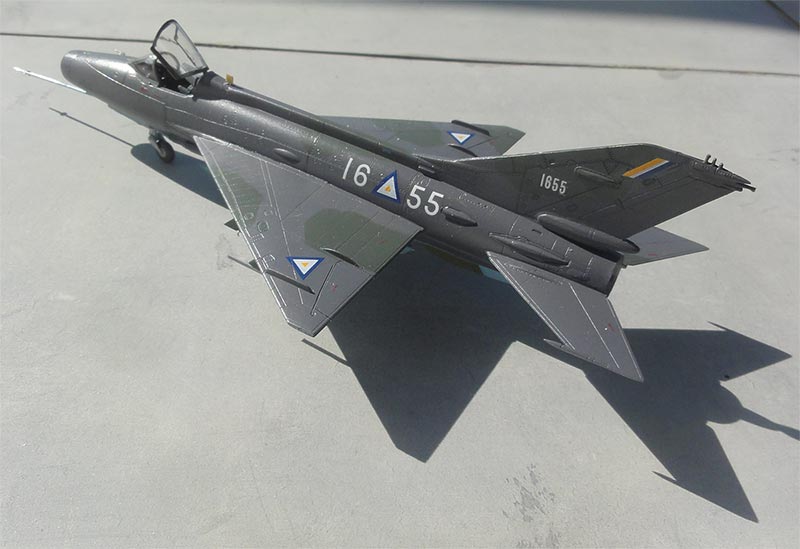



Chengdu F-7M / F-7iiK "Air Guard", Myanmar air force, coded "16 - 55"
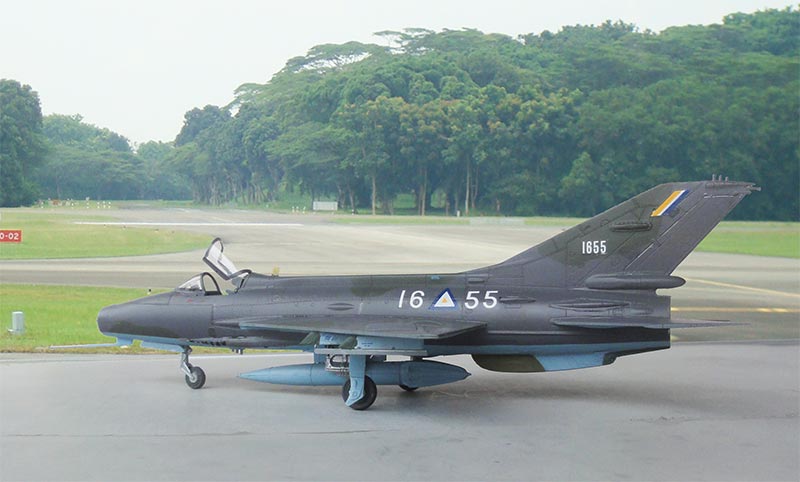
On to next MiG-21 [ Page 7.... ]
Back to 1/72 Models.......

(c) Copyright Meindert "designer"/ All rights reserved. Your comments are welcomed by webmaster
Created this page
July 25, 2018